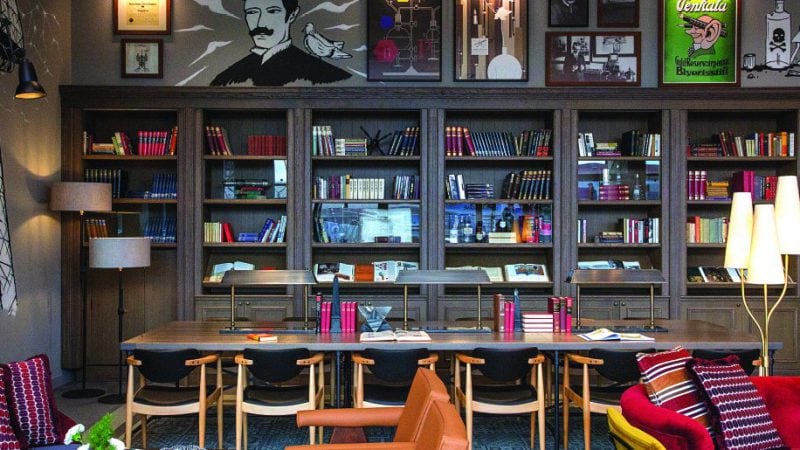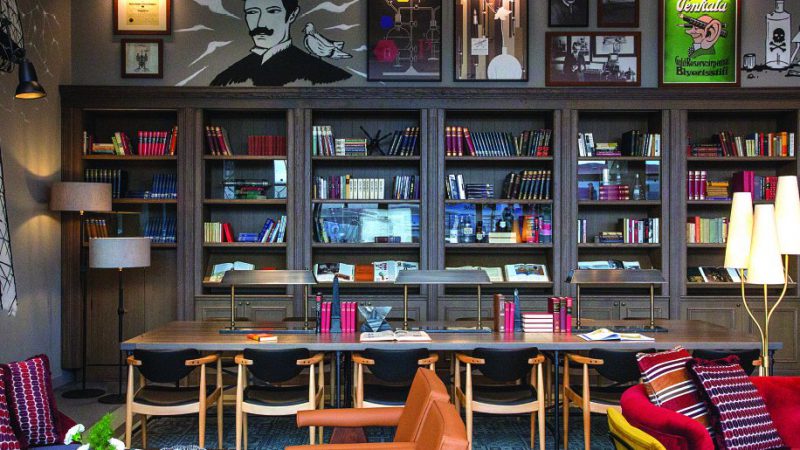Come On In
From budget to luxury, hotel brands are transforming lobbies into social hubs for guests and locals alike
June 29, 2019

We’ve all hung around in hotel lobbies and the chances are it has been pretty boring. We might have been waiting for a taxi or using it as a meeting point with fellow travelers before going off somewhere else. But it’s unlikely that we would have spent a portion of our working day in one, or looked forward to an evening’s entertainment there.
And yet that’s what the hotel brands now want us to contemplate. In fact, they see it as the future.
“Whether you call it the lobby or a lobby lounge, there are smarter ways of using a hotel’s public spaces,” says Jay Stein, chief executive of Dream Hotel Group. “It’s the concept surrounding: ‘Is your hotel there for the community or just for the hotel guests?’”
Dream Hotel Group prides itself on making the lobby a place of excitement and events. “You want the hotel guest and the local community to see that energy, so you need fun things throughout the public spaces. We’ll have a mixture of permanent features – like a hipster hair salon that celebrities get their hair cut in – and pop-up ones.”
Stein explains the synergies in today’s social media world. “We’ll bring an artist in and have a wall where they can do their thing and we’ll time-lapse it on social media. So we had James Goldcrown doing his graffiti art in one hotel – he painted the whole wall on Valentine’s Day – and then we got a famous tattoo artist who sat in the lobby that day and did free tattoos, but only of hearts.” Stein admits that he “had to get a lot of approvals from [his] legal team for that one” but adds: “The amount of social media attention we got off that was insane.”
It’s more than getting Millennials to post on their Instagram accounts, though – there’s hard business reality behind what Dream is doing. “If I am just going to rely on hotel guests for my revenue then I have a problem,” Stein says. “Instead, we have rooftop bars taking $20 million a year, and 90 percent of that is from beverage, so it’s very profitable. If I was just focused on the hotel guest, I could only do a 20th of that.”
Gathering Place
It’s this philosophy that many, if not most, hotel brands are beginning to subscribe to, and if you need an example of how it will hit the mainstream, consider the reinvention of Sheraton. The hotel chain’s new owner Marriott International sees its task as “dusting off an icon,” as Scott McCoy, vice-president of global operations for Marriott, Sheraton and Delta Hotels, puts it.
Sheraton will “recapture” its reputation as “the world’s gathering place,” taking advantage of the prime location it occupies in many cities. “The DNA that we want to keep is the sense of community,” McCoy says. “Sheraton is the gathering place, the community square for so many of these locations.” It will do this by completely redesigning its lobbies, incorporating elements to encourage people to linger, eat, hold meetings and then, finally, in the evening, spend money at new bars that will be created.
As Matthew Boettcher, senior director of global operations, experience design and brand operations, says of their guests, “We were watching them leave. We’d ask them where they were going and they’d say: ‘I have to meet a client,’ and if we asked them why they were meeting them somewhere else, they wouldn’t want to say.”
Boettcher is quick to point out that there are many fine examples of Sheratons around the world, but says the brand “kind of lost its way in certain parts of the world, the US being one of them. Europe is split; we have some amazing ones and some that are struggling a little.”
Several new features are therefore being introduced. They include “community” tables – first seen at Ace Hotels, although adapted with lockable drawers if you want to leave for a while – and soundproofed phone booths allowing you to make calls without being overheard. There will also be small glass meeting booths – called Studios – with capacity for between two and perhaps eight attendees. Studios then become private social spaces in the evening. The concepts will first be tested in 12 hotels globally before being rolled out around the world.
Changing Perceptions
Thought has also gone into the food offering, since, as Boettcher points out, “it’s difficult to eat a bowl of ramen while trying to work.” Dishes that can be eaten “one-handed” or “eyes-up” will be available from the bizarrely named “coffee bar bar,” which is licensed to serve alcohol and will offer everything from grab-and-go to counter and table service.
Boettcher says that by focusing on the public space, they can change the perception of the Sheraton brand “not just for guests but also for locals. The inspiration for the world’s gathering place is town squares, so we wanted to do that same exact thing.”
The town square concept is also the inspiration behind changes IHG is making this year to some of its Crowne Plaza hotels. A spokesperson says, “In Europe we are redefining the traditional lobby and guest room in partnership with Conran and Partners at flagship Crowne Plaza properties in Paris, Hamburg and London Heathrow. The new public space, known as the Plaza Workspace, combines co-working areas with food and drink options, ‘huddle spots’ and pods.”
In the US, the Workspace concept will be in place in more than 35 hotels, including its four flagship properties in New York, Atlanta, Denver and Seattle, by the end of the year.
Think Local
John Rogers, senior vice-president of brands and franchise operations at Hilton, says that a number of factors are driving lobby redevelopment in hotels. “Customers increasingly want unique experiences and more localized food and beverage,” he says, “and there is also a trend towards informality in dining and meeting spaces.”
At the same time, advances in technology are changing how the lobby is used. “The traditional function of the lobby space is becoming redundant as we allow you to choose your room online and use mobile check-in,” Rogers says.
Hilton has 17 brands and each is responding in different ways, Rogers says. In Hilton’s Canopy hotels in Reykjavik and Zagreb, there is a “strong connectivity to the local experience and the local market,” he says.
It’s something that budget brands such as Ibis have also latched on to. Its parent group, Accor, has already experimented with various ways to bring in the local community, not least with the trial of Accorlocal, which allows locals to use the services in their nearby hotel, from dry cleaning to picking up packages. As Accor chief executive Sébastien Bazin says, the aim is to engage people who “know our brands and walk past the hotel, but they don’t enter because they are afraid someone will ask them: ‘What’s your room number?’ And they don’t have one because they live next door.”
Ibis, which has more than 1,100 hotels, is revamping its lobbies to include mobile check-in, a transformed bar area and a live music program (rooms are also being redesigned). The idea is that technology will take over from reception desks so that staff, now known as the “Smile Team,” will be freed up to engage with guests.
In this endeavor, Accor is certainly backed by quantitative social research. An Ipsos study conducted on behalf of Ibis revealed that 61 percent of survey respondents would rather be greeted by an individual than by a technology solution during check-in and check-out, indicating the challenge of giving people the option of seamless check-in, but with a human face. According to Ipsos, 80 percent of respondents also want hotels to be social venues that accommodate both hotel and non-hotel guests.
At the luxury end, hotels are attempting the same. Radha Arora, president of Rosewood Hotels and Resorts, says: “Affluence and materials can only take you so far. It’s experiences that are irreplaceable. So in Paris we have created a Parisian living room, where you’ll find local fashionistas and community artists. And when clients walk in, no matter where they are from, they say: ‘This is Paris.’”
Return on Investment Behind all of this, there is, of course, the business of making money. “As hoteliers, lobby space is some of the most expensive space we build, generating very little return,” says Peter Fulton, Hyatt Hotels’ group president for Europe, the Middle East, Africa and Southwest Asia, “People are using spaces in a different way from how they used to.”
Hilton’s Rogers says there is an “ever-increasing desire to maximize the returns on the space. It needs to be a continuous process, constantly innovating that product and the way you deploy it.”
Can the big chains really succeed in this? Eric Jafari, managing director of serviced apartment specialist Saco Property Group, doubts it. “Hotels are stuck in the eighties,” he says. “When they say they want to glimpse local living, their response is, if in Berlin, to put up a bunch of pictures of Berlin, or have some exposed brick and call it local living.”
Jafari is a co-founder of Saco’s Locke aparthotel brand, which aims “to reflect the local neighborhood’s culture, taking inspiration from the area to connect guests with like-minded locals and other travelers.” However, he adds, “when you have decision makers who are not the consumer, and they are seeing what other people are doing and copying it, it very rarely works, because they don’t understand the soul and the essence of why it works.”
Stein of Dream Hotel Group agrees. “If the big brands can pull it off, then great, but to bring a formula into every Sheraton and get it to work, that’s where it’s more difficult,” he says. “We look at what will work in the local market. Hotels aren’t like airlines. The Dream hotel in Bangkok isn’t going to be like the one in Seattle or Nashville.”
As Stein says, the Holy Grail for hotels is being the “hot” place for locals. But then there’s the potential conflict of satisfying hotel guests at the same time. “It’s difficult for the big brands to get their arms around the fact that you’re not worrying about the hotel guests first,” he says, “but until you do that, you’re not going to do it well.”
So what if guests don’t like a lobby crowded with locals sipping flat whites and having free tattoos? “The reality is, if I do all these fun things, very few guests come down to the lobby or bar and say to themselves: ‘Who are all these good-looking locals having fun? I’m going to complain.’”
It’s possible, though, surely? “Right, but those are problems I want to have. I want too many locals wanting to use it and guests complaining. And then let me figure out a solution. If I have no problems, then I have no business.”




